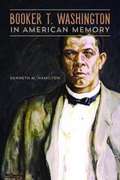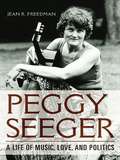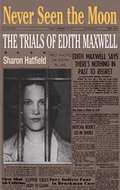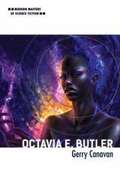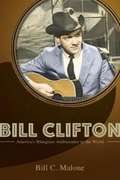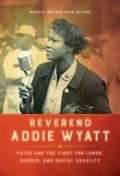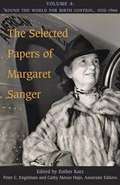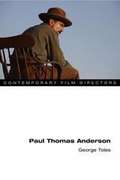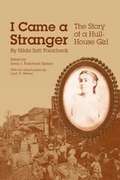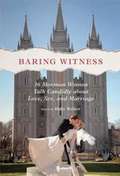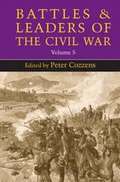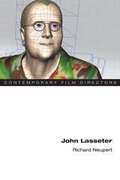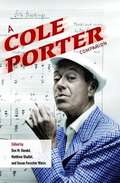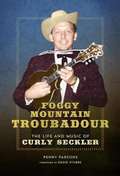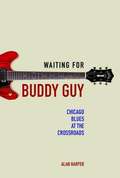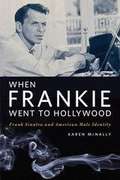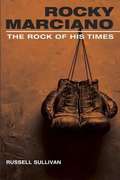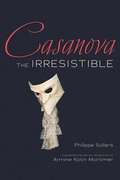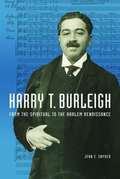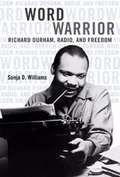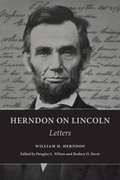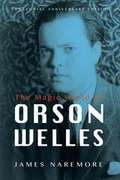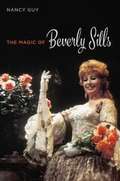- Table View
- List View
Booker T. Washington in American Memory
by Kenneth M. HamiltonSince the 1960s, many historians have condemned Booker T. Washington as a problematic, even negative, influence on African American progress. This attitude dramatically contrasts with the nationwide outpouring of grief and reverence that followed Washington's death in 1915. Kenneth M. Hamilton describes how, when, where, and why Americans commemorated the life of Booker T. Washington. For months following his death, tens of thousands of Americans, especially blacks, honored his memory. Their memorials revealed that Washington enjoyed widespread national support for his vision of America and the programs that he imparted to achieve his aspirations. Their actions and articulations provide rich insight into how a cross section of Washington's contemporaries viewed him. From private messages of solace to public pronouncements, countless Americans portrayed him as a revered national icon. Among other characteristics, commemorates voiced their appreciation of his humanitarianism, humility, nationalism, perseverance, philanthropy, progressivism, spirituality, and wisdom. Washington was the leading advocate of the Yankee Protestantism Ethic, which promoted education, and personal qualities such as pragmatism, perseverance, cleanliness, thrift, and the dignity of labor among African Americans.
Peggy Seeger: A Life of Music, Love, and Politics
by Jean R. FreedmanBorn into folk music's first family, Peggy Seeger has blazed her own trail artistically and personally. Jean Freedman draws on a wealth of research and conversations with Seeger to tell the life story of one of music's most charismatic performers and tireless advocates. Here is the story of Seeger's multifaceted career, from her youth to her pivotal role in the American and British folk revivals, from her instrumental virtuosity to her tireless work on behalf of environmental and feminist causes, from wry reflections on the U.K. folk scene to decades as a songwriter. Freedman also delves into Seeger's fruitful partnership with Ewan MacColl and a multitude of contributions which include creating the renowned Festivals of Fools, founding Blackthorne Records, masterminding the legendary Radio Ballads documentaries, and mentoring performers in the often-fraught atmosphere of The Critics Group. Bracingly candid and as passionate as its subject, Peggy Seeger is the first book-length biography of a life set to music.
Cristi Puiu (Contemporary Film Directors)
by Monica FilimonCristi Puiu's black comedy The Death of Mr. Lazarescu announced the arrival of the New Romanian Cinema as a force on the film world stage. As critics and festival audiences embraced the new movement, Puiu emerged as its lodestar and critical voice. Monica Filimon explores the works of an artist dedicated to truth not as an abstract concept, but as the ephemeral revelation of the fuller, ungraspable world beyond the screen. Puiu's innovative use of the handheld camera as an observer and his reliance on austere, restricted narration highlight the very limits of human understanding, guiding the viewer's intellectual and emotional sensibilities to the reality that has been left unfilmed. Filimon examines the director's ethics of epiphany not only in relation to the collective and personal histories that have triggered it, but also in dialogue with the films, texts, and filmmakers that have shaped it.
Never Seen the Moon: The Trials of Edith Maxwell
by Sharon HatfieldNever Seen the Moon carefully yet lucidly recreates a young woman's wild ride through the American legal system. In 1935, free-spirited young teacher Edith Maxwell and her mother were indicted for murdering Edith's conservative and domineering father, Trigg, late one July night in their Wise County, Virginia, home. Edith claimed her father had tried to whip her for staying out late. She said that she had defended herself by striking back with a high-heeled shoe, thus earning herself the sobriquet "slipper slayer." Immediately granted celebrity status by the powerful Hearst press, Maxwell was also championed as a martyr by advocates of women's causes. National news magazines and even detective magazines picked up her story, Warner Brothers created a screen version, and Eleanor Roosevelt helped secure her early release from prison. Sharon Hatfield's brilliant telling of this true-crime story transforms a dusty piece of history into a vibrant thriller. Throughout the narrative, she discusses yellow journalism, the inequities of the jury system, class and gender tensions in a developing region, and a woman's right to defend herself from family violence.
Octavia E. Butler (Modern Masters of Science Fiction)
by Gerry CanavanI began writing about power because I had so little, Octavia E. Butler once said. Butler's life as an African American woman--an alien in American society and among science fiction writers--informed the powerful works that earned her an ardent readership and acclaim both inside and outside science fiction. Gerry Canavan offers a critical and holistic consideration of Butler's career. Drawing on Butler's personal papers, Canavan tracks the false starts, abandoned drafts, tireless rewrites, and real-life obstacles that fed Butler's frustrations and launched her triumphs. Canavan departs from other studies to approach Butler first and foremost as a science fiction writer working within, responding to, and reacting against the genre's particular canon. The result is an illuminating study of how an essential SF figure shaped themes, unconventional ideas, and an unflagging creative urge into brilliant works of fiction.
Alfred Bester
by Jad SmithAlfred Bester's classic short stories and the canonical novel The Stars My Destination made him a science fiction legend. Fans and scholars praise him as a genre-bending pioneer and cyberpunk forefather. Writers like Neil Gaiman and William Gibson celebrate his prophetic vision and stylistic innovations. Jad Smith traces the career of the unlikeliest of SF icons. Winner of the first Hugo Award for The Demolished Man , Bester also worked in comics, radio, and TV, and his intermittent SF writing led some critics to brand him a dabbler. In the 1960s, however, New Wave writers championed his work, and his reputation grew. Smith follows Bester's journey from consummate outsider to an artist venerated for foundational works that influenced the New Wave and cyberpunk revolutions. He also explores the little-known roots of a wayward journey fueled by curiosity, disappointment with the SF mainstream, and an artist's determination to go his own way.
Bill Clifton: America's Bluegrass Ambassador to the World
by Bill C MaloneThe most atypical of bluegrass artists, Bill Clifton has enjoyed a long career as a recording artist, performer, and champion of old-time music. Bill C. Malone pens the story of Clifton's eclectic life and influential career. Born into a prominent Maryland family, Clifton connected with old-time music as a boy. Clifton made records around earning a Master's degree, fifteen years in the British folk scene, and stints in the Peace Corps and Marines. Yet that was just the beginning. Closely allied with the Carter Family, Woody Guthrie, Mike Seeger, and others, Clifton altered our very perceptions of the music--organizing one of the first outdoor bluegrass festivals, publishing a book of folk and gospel standards that became a cornerstone of the folk revival, and introducing both traditional and progressive bluegrass around the world. As Malone shows, Clifton clothed the music of working-class people in the vestments of romance, celebrating the log cabin as a refuge from modernism that rang with the timeless music of Appalachia. An entertaining account by an eminent music historian, Bill Clifton clarifies the myths and illuminates the paradoxes of an amazing musical life.
Reverend Addie Wyatt: Faith and the Fight for Labor, Gender, and Racial Equality (Women, Gender, and Sexuality in American History)
by Marcia Walker-McwilliamsLabor leader, civil rights activist, outspoken feminist, African American clergywoman--Reverend Addie Wyatt stood at the confluence of many rivers of change in twentieth century America. The first female president of a local chapter of the United Packinghouse Workers of America, Wyatt worked alongside Martin Luther King Jr. and Eleanor Roosevelt and appeared as one of Time magazine's Women of the Year in 1975. Marcia Walker-McWilliams tells the incredible story of Addie Wyatt and her times. What began for Wyatt as a journey to overcome poverty became a lifetime commitment to social justice and the collective struggle against economic, racial, and gender inequalities. Walker-McWilliams illuminates how Wyatt's own experiences with hardship and many forms of discrimination drove her work as an activist and leader. A parallel journey led her to develop an abiding spiritual faith, one that denied defeatism by refusing to accept such circumstances as immutable social forces.
The Selected Papers of Margaret Sanger, Volume 4: Round the World for Birth Control, 1920-1966
by Margaret Sanger Cathy Moran Hajo Esther Katz Peter C. EngelmanWhen Margaret Sanger returned to Europe in 1920, World War I had altered the social landscape as dramatically as it had the map of Europe. Population concerns, sexuality, venereal disease, and contraceptive use had entered public discussion, and Sanger's birth control message found receptive audiences around the world. This volume focuses on Sanger from her groundbreaking overseas advocacy during the interwar years through her postwar role in creating the International Planned Parenthood Federation. The documents reconstruct Sanger's dramatic birth control advocacy tours through early 1920s Germany, Japan, and China in the midst of significant government and religious opposition to her ideas. They also trace her tireless efforts to build a global movement through international conferences and tours. Letters, journal entries, writings, and other records reveal Sanger's contentious dealings with other activists, her correspondence with the likes of Albert Einstein and Eleanor Roosevelt, and Sanger's own dramatic evolution from gritty grassroots activist to postwar power broker and diplomat.
Paul Thomas Anderson (Contemporary Film Directors)
by George TolesSince his explosive debut with the indie sensation Hard Eight , Paul Thomas Anderson has established himself as one of contemporary cinema's most exciting artists. His 2002 feature Punch-Drunk Love radically reimagined the romantic comedy. Critics hailed There Will Be Blood as a key film of the new millennium. In The Master , Anderson jarred audiences with dreamy amorphousness and a departure from conventional story mechanics. Acclaimed film scholar and screenwriter George Toles approaches these three films in particular, and Anderson's oeuvre in general, with a focus on the role of emergence and the production of the unaccountable. Anderson, Toles shows, is an artist obsessed with history, workplaces, and environments but also intrigued by spaces as projections of the people who dwell within. Toles follows Anderson from the open narratives of Boogie Nights and Magnolia through the pivot that led to his more recent films, Janus-faced masterpieces that orbit around isolated central characters--and advance Anderson's journey into allegory and myth. Blending penetrative analysis with a deep knowledge of filmic storytelling, Paul Thomas Anderson tours an important filmmaker's ever-deepening landscape of disconnection.
I Came a Stranger: The Story of a Hull-House Girl (Women, Gender, and Sexuality in American History)
by Hilda PolacheckHilda Satt Polacheck's family emigrated from Poland to Chicago in 1892, bringing their old-world Jewish traditions with them into the Industrial Age. Throughout her career as a writer and activist, Polacheck (1882-1967) never forgot the immigrant neighborhoods, the markets, and the scents and sounds of Chicago's West Side. Here, in charming and colorful prose, she recounts her introduction to American life and the Hull-House community, her friendship with Jane Addams, her marriage, her support of civil rights, woman suffrage, and the Women's International League for Peace and Freedom, and her experiences as a writer for the WPA.
Baring Witness: 36 Mormon Women Talk Candidly about Love, Sex, and Marriage
by Holly WelkerIn Baring Witness , Welker and thirty-six Mormon women write about devotion and love and luck, about the wonder of discovery, and about the journeys, both thorny and magical, to humor, grace, and contentment. They speak to a diversity of life experiences: what happens when one partner rejects Church teachings; marrying outside one's faith; the pain of divorce and widowhood; the horrors of spousal abuse; the hard journey from visions of an idealized marriage to the everyday truth; sexuality within Mormon marriage; how the pressure to find a husband shapes young women's actions and sense of self; and the ways Mormon belief and culture can influence second marriages and same-sex unions. The result is an unflinching look at the earthly realities of an institution central to Mormon life.
Battles and Leaders of the Civil War, Volume 5
by Peter CozzensIndispensable must-reads for all Civil War buffs and historians, bringing together little-known and never before gathered first-hand accounts, articles, maps, and illustrations The first four volumes of Battles and Leaders of the Civil War, published in the late nineteenth century, became the best-selling and most frequently cited works ever published on the Civil War. Volume 5, assembled by the acclaimed military historian Peter Cozzens, carries on the tradition of its namesake, offering a dazzling new collection of fresh material written by military and civilian leaders, North and South, on a broad array of war-related topics. Featured articles include General Grant on the second battle of Bull Run, General Beauregard on the Shiloh campaign, General Sherman on the conference at City Point, Joshua Chamberlain on the Fredericksburg campaign, and many more. Also presented are dozens of maps and more than one hundred illustrations.
John Lasseter (Contemporary Film Directors)
by Richard NeupertCelebrated as Pixar's "Chief Creative Officer," John Lasseter is a revolutionary figure in animation history and one of today's most important filmmakers. Lasseter films from Luxo Jr. to Toy Story and Cars 2 highlighted his gift for creating emotionally engaging characters. At the same time, they helped launch computer animation as a viable commercial medium and serve as blueprints for the genre's still-expanding commercial and artistic development. Richard Neupert explores Lasseter's signature aesthetic and storytelling strategies and details how he became the architect of Pixar's studio style. Neupert contends that Lasseter's accomplishments emerged from a unique blend of technical skill and artistic vision, as well as a passion for working with collaborators. In addition, Neupert traces the director's career arc from the time Lasseter joined Pixar in 1984. As Neupert shows, Lasseter's ability to keep a foot in both animation and CGI allowed him to thrive in an unconventional corporate culture that valued creative interaction between colleagues. The ideas that emerged built an animation studio that updated and refined classical Hollywood storytelling practices--and changed commercial animation forever.
A Cole Porter Companion
by Susan Forscher Weiss Matthew Shaftel Don M. RandelBalancing sophisticated melodies and irresistible rhythms with lyrics by turns cynical and passionate, Cole Porter sent American song soaring on gossamer wings. Timeless works like "I Get a Kick Out of You" and "At Long Last Love" made him an essential figure in the soundtrack of a century and earned him adoration from generations of music lovers. In A Cole Porter Companion , a parade of performers and scholars offers essays on little-known aspects of the master tunesmith's life and art. Here are Porter's days as a Yale wunderkind and his nights as the exemplar of louche living; the triumph of Kiss Me Kate and shocking failure of You Never Know ; and his spinning rhythmic genius and a turkey dinner into "You're the Top" while cultural and economic forces take "Ev'ry Time We Say Goodbye" in unforeseen directions. Other entries explore notes on ongoing Porter scholarship and delve into his formative works, performing career, and long-overlooked contributions to media as varied as film and ballet. Prepared with the cooperation of the Porter archives, A Cole Porter Companion is an invaluable guide for the fans and scholars of this beloved American genius.
Foggy Mountain Troubadour: The Life and Music of Curly Seckler (Music in American Life)
by Penny ParsonsWith his trademark mandolin style and unequaled tenor harmonies, Curly Seckler has carved out a seventy-seven-year career in bluegrass and country music. His foundational work in Flatt and Scruggs's Foggy Mountain Boys secured him a place in bluegrass history, while his role in The Nashville Grass made him an essential part of the music's triumphant 1970s revival. Written in close collaboration with Mr. Seckler and those who know him, Foggy Mountain Troubadour is the first full-length biography of an American original. Penny Parsons follows a journey from North Carolina schoolhouses to the Grand Ole Opry stage and the Bluegrass Hall of Fame, from boarding houses to radio studios and traveling five to a car on two-lane roads to make the next show. Throughout, she captures the warm humor, hard choices, and vivid details of a brilliant artist's life as he crisscrosses a nation and a century making music.
Waiting for Buddy Guy: Chicago Blues at the Crossroads
by Alan HarperIn the late 1970s and early 1980s, British blues fan Alan Harper became a transatlantic pilgrim to Chicago. "I've come here to listen to the blues," he told an American customs agent at the airport, and listen he did, to the music in its many styles, and to the men and women who lived it in the city's changing blues scene. Harper's eloquent memoir conjures the smoky redoubts of men like harmonica virtuoso Big Walter Horton and pianist Sunnyland Slim. Venturing from stageside to kitchen tables to the shotgun seat of a 1973 Eldorado, Harper listens to performers and others recollect memories of triumphs earned and chances forever lost, of deep wells of pain and soaring flights of inspiration. Harper also chronicles a time of change, as an up-tempo, whites-friendly blues eclipsed what had come before, and old Southern-born black players held court one last time before an all-conquering generation of young guitar aces took center stage.
When Frankie Went to Hollywood: Frank Sinatra and American Male Identity
by Karen McnallyThis first in-depth study of Frank Sinatra's film career explores his iconic status in relation to his many performances in postwar Hollywood cinema. When Frankie Went to Hollywood considers how Sinatra's musical acts, television appearances, and public commentary impacted his screen performances in Pal Joey, The Tender Trap, Some Came Running, The Man with the Golden Arm, and other hits. A lively discussion of sexuality, class, race, ethnicity, and male vulnerability in postwar American culture illuminates Karen McNally's investigation into Sinatra's cinematic roles and public persona. This entertainment luminary, she finds, was central in shaping debates surrounding definitions of American male identity in the 1940s and '50s.
Rocky Marciano: The Rock of His Times (Sport and Society)
by Russell SullivanIn this captivating and complex portrait of an American sports legend, Russell Sullivan confirms Rocky Marciano's place as a symbol and cultural icon of his era. As much as he embodied the wholesome, rags-to-riches patriotism of a true American hero, he also reflected the racial and ethnic tensions festering behind the country's benevolent facade. Spirited, fast-paced, and rich in detail, Rocky Marciano is the first book to place the boxer in the context of his times. Capturing his athletic accomplishments against the colorful backdrop of the 1950s fight scene, Sullivan examines how Marciano's career reflected the glamour and scandal of boxing as well as tenor of his times.
Casanova the Irresistible
by Armine Kotin Mortimer Phillippe SollersHis is a name synonymous with seduction. His was a life lived without limits. Giacomo Casanova left behind thousands of pages detailing his years among Europe's notable and noble. In Casanova the Irresistible, Philippe Sollers--prolific intellectual and revered visionary of the French avant-garde--proffers a lively reading of and guide to the famed libertine's sprawling memoir. Armine Kotin Mortimer's translation of Sollers's reading tracks the alluring Venetian through the whole of his astounding and disreputable life. Eschewing myth, Sollers dares to present the plain realities of a man "simple, direct, courageous, cultivated, seductive, funny. A philosopher in action." The lovers are here, and the ruses and adventures. But Sollers also rescues Casanova the writer, a gifted composer of words who reigns as a titan of eighteenth-century literature. As always, Sollers seeks to shame society for its failure to recognize its failings. By admiring those of Casanova's admirable qualities present in himself, Sollers spurns bourgeois hypocrisy and cliché to affirm a jocund philosophy of life devoted to the twinned pursuits of pleasure and joy. A masterful translation that captures Sollers's idiosyncratic style, Casanova the Irresistible escorts readers on a journey into the heads and hearts of two singular personalities.
Harry T. Burleigh: From the Spiritual to the Harlem Renaissance
by Jean E SnyderHarry T. Burleigh (1866-1949) played a leading role in American music and culture in the twentieth century. Celebrated for his arrangements of spirituals, Burleigh was also the first African American composer to create a significant body of art song. An international roster of opera and recital singers performed his works and praised them as among the best of their time. Jean E. Snyder traces Burleigh's life from his Pennsylvania childhood through his fifty-year tenure as soloist at St. George's Episcopal Church in Manhattan. As a composer, Burleigh's pioneering work preserved and transformed the African American spiritual; as a music editor, he facilitated the work of other black composers; as a role model, vocal coach, and mentor, he profoundly influenced American song; and in private life he was friends with AntonÃn DvoÅTMák, Marian Anderson, Will Marion Cook, and other America luminaries. Snyder provides rich historical, social, and political contexts that explore Burleigh's professional and personal life within an era complicated by changes in race relations, class expectations, and musical tastes.
Word Warrior: Richard Durham, Radio, and Freedom
by Sonja D WilliamsPosthumously inducted into the National Radio Hall of Fame in 2007, Richard Durham creatively chronicled and brought to life the significant events of his times. Durham's trademark narrative style engaged listeners with fascinating characters, compelling details, and sharp images of pivotal moments in American and African American history and culture. In Word Warrior , award-winning radio producer Sonja D. Williams draws on archives and hard-to-access family records, as well as interviews with family and colleagues like Studs Terkel and Toni Morrison, to illuminate Durham's astounding career. Durham paved the way for black journalists as a dramatist and a star investigative reporter and editor for the pioneering black newspapers the Chicago Defender and Muhammed Speaks . Talented and versatile, he also created the acclaimed radio series Destination Freedom and Here Comes Tomorrow and wrote for popular radio fare like The Lone Ranger . Incredibly, his energies extended still further--to community and labor organizing, advising Chicago mayoral hopeful Harold Washington, and mentoring generations of activists. Incisive and in-depth, Word Warrior tells the story of a tireless champion of African American freedom, equality, and justice during an epoch that forever changed a nation.
Herndon on Lincoln: Letters
by Douglas L. Wilson Rodney O. Davis William H. HerndonAfter Abraham Lincoln's assassination in 1865, William H. Herndon began work on a brief, "subjective" biography of his former law partner, but his research turned up such unexpected and often startling information that it became a lifelong obsession. The biography finally published in 1889, Herndon's Lincoln, was a collaboration with Jesse W. Weik in which Herndon provided the materials and Weik did almost all the writing. For this reason, and because so much of what Herndon had to say about Lincoln was not included in the biography, David Donald has observed, "To understand Herndon's own rather peculiar approach to Lincoln biography, one must go back to his letters." An exhaustive collection of what Herndon was told by others about Lincoln was published by Douglas L. Wilson and Rodney O. Davis in Herndon's Informants: Letters, Interviews, and Statements about Abraham Lincoln . In this new volume, Wilson and Davis have produced a comprehensive edition of what Herndon himself wrote about Lincoln in his own letters. Because of Herndon's close association with Lincoln, his intimate acquaintance with his partner's legal and political careers, and because he sought out informants who knew Lincoln and preserved information that might otherwise have been lost, his letters have become an indispensable resource for Lincoln biography. Unfiltered by a collaborator and rendered in Herndon's own distinctive voice, these letters constitute a matchless trove of primary source material. Herndon on Lincoln: Letters is a must for libraries, research institutions, and students of a towering American figure and his times.
The Magic World of Orson Welles
by James NaremoreProdigy. Iconoclast. Genius. Exile. Orson Welles remains one of the most discussed figures in cinematic history. In the centenary year of Welles's birth, James Naremore presents a revised third edition of this incomparable study, including a new section on the unfinished film The Other Side of the Wind . Naremore analyzes the political and psychological implications of the films, Welles's idiosyncratic style, and the biographical details--both playful and vexing--that impacted each work. Itself a historic film study, The Magic World of Orson Welles unlocks the soaring art and quixotic methods of a master.
The Magic of Beverly Sills
by Nancy GuyWith her superb coloratura soprano, passion for the world of opera, and down-to-earth personality, Beverly Sills made high art accessible to millions from the time of her meteoric rise to stardom in 1966 until her death in 2007. An unlikely pop culture phenomenon, Sills was equally at ease on talk shows, on the stage, and in the role of arts advocate and administrator. Merging archival research with her own love of Sills's music, Nancy Guy examines the singer-actress's artistry alongside the ineffable aspects of performance that earned Sills a passionate fandom. Guy mines the memories of colleagues, critics, and aficionados to recover something of the spell Sills wove for people on both sides of the footlights during the hot moments of onstage performance. At the same time, she analyzes essential questions raised by Sills's art and celebrity. How did Sills challenge the divide between elite and mass culture and build a fan base that crossed generations and socio-economic lines? Above all, how did Sills capture the unnameable magic that joins the members of an audience to a performer--and to one-another? Intimate and revealing, The Magic of Beverly Sills explores the alchemy of art, magnetism, community, and emotion that produced an American icon.
